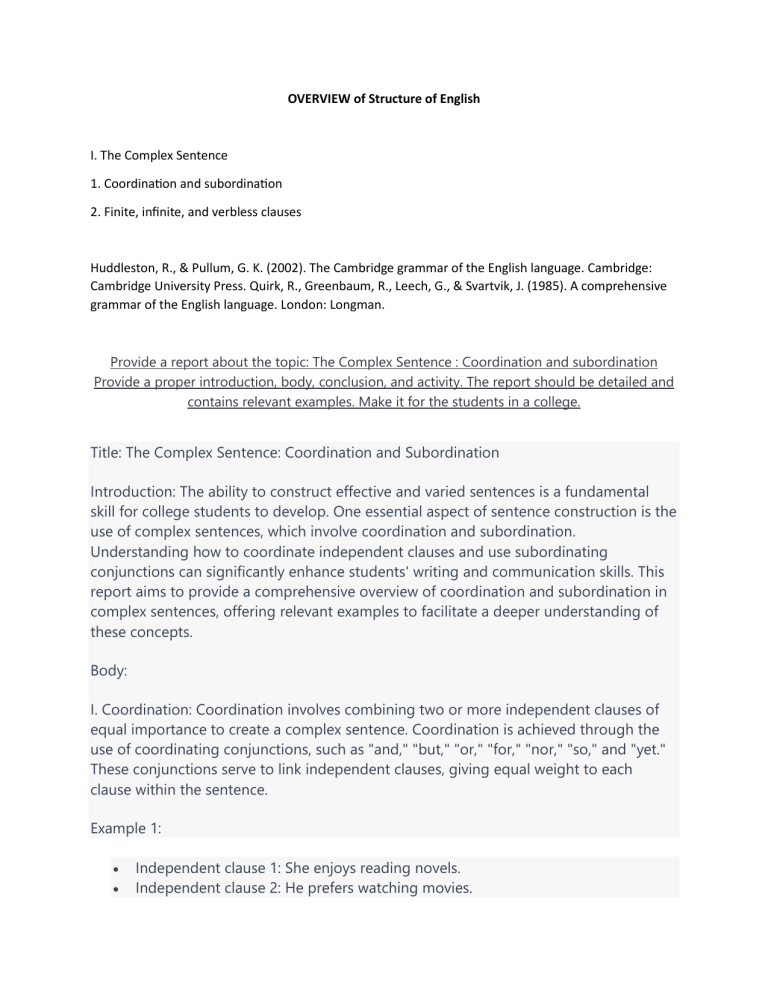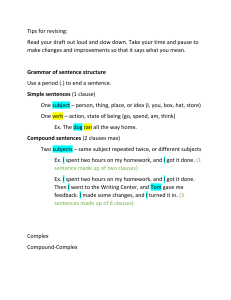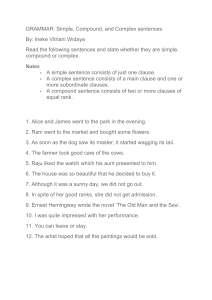
OVERVIEW of Structure of English I. The Complex Sentence 1. Coordination and subordination 2. Finite, infinite, and verbless clauses Huddleston, R., & Pullum, G. K. (2002). The Cambridge grammar of the English language. Cambridge: Cambridge University Press. Quirk, R., Greenbaum, R., Leech, G., & Svartvik, J. (1985). A comprehensive grammar of the English language. London: Longman. Provide a report about the topic: The Complex Sentence : Coordination and subordination Provide a proper introduction, body, conclusion, and activity. The report should be detailed and contains relevant examples. Make it for the students in a college. Title: The Complex Sentence: Coordination and Subordination Introduction: The ability to construct effective and varied sentences is a fundamental skill for college students to develop. One essential aspect of sentence construction is the use of complex sentences, which involve coordination and subordination. Understanding how to coordinate independent clauses and use subordinating conjunctions can significantly enhance students' writing and communication skills. This report aims to provide a comprehensive overview of coordination and subordination in complex sentences, offering relevant examples to facilitate a deeper understanding of these concepts. Body: I. Coordination: Coordination involves combining two or more independent clauses of equal importance to create a complex sentence. Coordination is achieved through the use of coordinating conjunctions, such as "and," "but," "or," "for," "nor," "so," and "yet." These conjunctions serve to link independent clauses, giving equal weight to each clause within the sentence. Example 1: Independent clause 1: She enjoys reading novels. Independent clause 2: He prefers watching movies. Coordinated Sentence: She enjoys reading novels, but he prefers watching movies. Example 2: Independent clause 1: The sun was shining brightly. Independent clause 2: The birds were chirping. Coordinated Sentence: The sun was shining brightly, and the birds were chirping. II. Subordination: Subordination involves combining an independent clause with one or more dependent clauses, creating a complex sentence in which one clause is subordinate to the other. Subordination is achieved through the use of subordinating conjunctions, such as "because," "although," "since," "when," "while," "if," "unless," and "until." These conjunctions establish a hierarchical relationship between the clauses, with the dependent clause providing additional information or modifying the independent clause. Example 1: Independent clause: He wanted to go to the beach. Dependent clause: because the weather was sunny. Subordinated Sentence: He wanted to go to the beach because the weather was sunny. Example 2: Independent clause: She will attend the conference. Dependent clause: if she finishes her assignment. Subordinated Sentence: She will attend the conference if she finishes her assignment. III. Coordination and Subordination Combined: Complex sentences often feature a combination of coordination and subordination, allowing for the expression of multiple ideas and relationships within a single sentence. Example 1: Independent clause 1: The students studied diligently. Dependent clause: because they wanted to excel in the exam. Independent clause 2: They also participated in extracurricular activities. Complex Sentence: The students studied diligently because they wanted to excel in the exam, and they also participated in extracurricular activities. Example 2: Independent clause 1: She loves playing tennis. Dependent clause: even though she is not very good at it. Independent clause 2: She plans to join the tennis club. Complex Sentence: She loves playing tennis even though she is not very good at it, and she plans to join the tennis club. Conclusion: Mastering the construction of complex sentences through coordination and subordination is a valuable skill for college students. Coordination allows for the combination of independent clauses of equal importance, while subordination enables the inclusion of dependent clauses that modify or provide additional information. By understanding and utilizing these techniques, students can enhance the clarity, coherence, and sophistication of their writing and communication. Activity: To reinforce the concepts of coordination and subordination, students can engage in the following activity: Activity: Sentence Transformation 1. Provide students with a list of simple sentences. 2. Instruct them to transform each simple sentence into a complex sentence by using coordination or subordination. 3. Encourage students to use appropriate coordinating or subordinating conjunctions to connect clauses effectively. 4. Review and discuss the transformed sentences as a class, highlighting the different ways coordination and subordination can be applied. 5. Provide feedback and clarification as needed to ensure students grasp the concepts. By actively practicing these techniques, students can develop proficiency in constructing complex sentences, enhancing their writing skills and overall language proficiency. Remember, mastering coordination and subordination in complex sentences requires practice and application in various contexts. The more students engage with these concepts, the more adept they will become at crafting well-structured and expressive sentences. Title: The Complex Sentence: Finite, Infinite, and Verbless Clauses Introduction: Developing a strong grasp of complex sentence structures is crucial for college students aiming to enhance their writing and communication skills. In addition to coordination and subordination, understanding the different types of clauses within complex sentences is essential. This report focuses on finite, infinite, and verbless clauses, shedding light on their unique characteristics and providing relevant examples. By comprehending these distinct types of clauses, students can construct complex sentences with greater precision and sophistication. Body: I. Finite Clauses: Finite clauses contain a finite verb and can function independently as complete sentences. They express a complete thought and typically include a subject and a predicate. Finite clauses play a crucial role in constructing complex sentences. Example 1: Finite Clause: She eats pizza. Complex Sentence: She eats pizza because it is her favorite food. Example 2: Finite Clause: They will go to the concert. Complex Sentence: They will go to the concert if they can get tickets. II. Infinite Clauses: Infinite clauses contain an infinitive verb form (e.g., to + verb) and cannot function independently as complete sentences. They function as dependent clauses within complex sentences, often serving as subjects, objects, or complements. Example 1: Infinite Clause: To succeed in life Complex Sentence: To succeed in life requires dedication and perseverance. Example 2: Infinite Clause: To learn a new language Complex Sentence: She decided to learn a new language in order to broaden her horizons. III. Verbless Clauses: Verbless clauses, as the name suggests, lack a finite or nonfinite verb. Instead, they rely on other elements, such as adjectives, adverbs, or nouns, to convey meaning. Verbless clauses often serve as modifiers within complex sentences. Example 1: Verbless Clause: Exhausted after a long day Complex Sentence: Exhausted after a long day, she collapsed on the couch. Example 2: Verbless Clause: A talented musician Complex Sentence: A talented musician, he impressed the audience with his performance. Conclusion: Understanding the distinctions between finite, infinite, and verbless clauses is crucial for constructing complex sentences that effectively convey meaning and nuance. Finite clauses function as independent sentences, while infinite clauses and verbless clauses serve as dependent clauses, providing additional information or modifying the main clause. By incorporating these different clause types, students can enhance the complexity and sophistication of their writing. Activity: To reinforce the understanding of finite, infinite, and verbless clauses, engage students in the following activity: Activity: Sentence Analysis and Reconstruction 1. Provide students with a set of sentences that contain different clause types (finite, infinite, and verbless). 2. Instruct students to identify the type of clause in each sentence and analyze its function within the sentence. 3. Ask students to reconstruct the sentences, transforming them into complex sentences by incorporating other types of clauses or modifying the existing clauses. 4. Encourage students to discuss their reconstructed sentences, explaining the changes they made and the impact on the overall meaning and structure. 5. Provide feedback and guidance to ensure students grasp the nuances of each clause type and can effectively apply them in their writing. By actively engaging in this activity, students will reinforce their understanding of finite, infinite, and verbless clauses, enabling them to construct complex sentences with greater proficiency and versatility. Remember, mastering the nuances of these clause types requires practice and application in various contexts. Encourage students to explore and experiment with different clause combinations to further enhance their writing skills and linguistic abilities.



